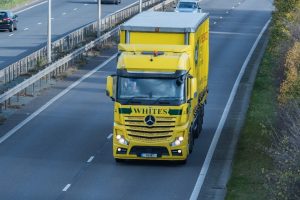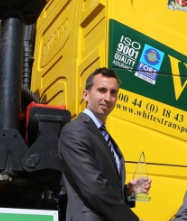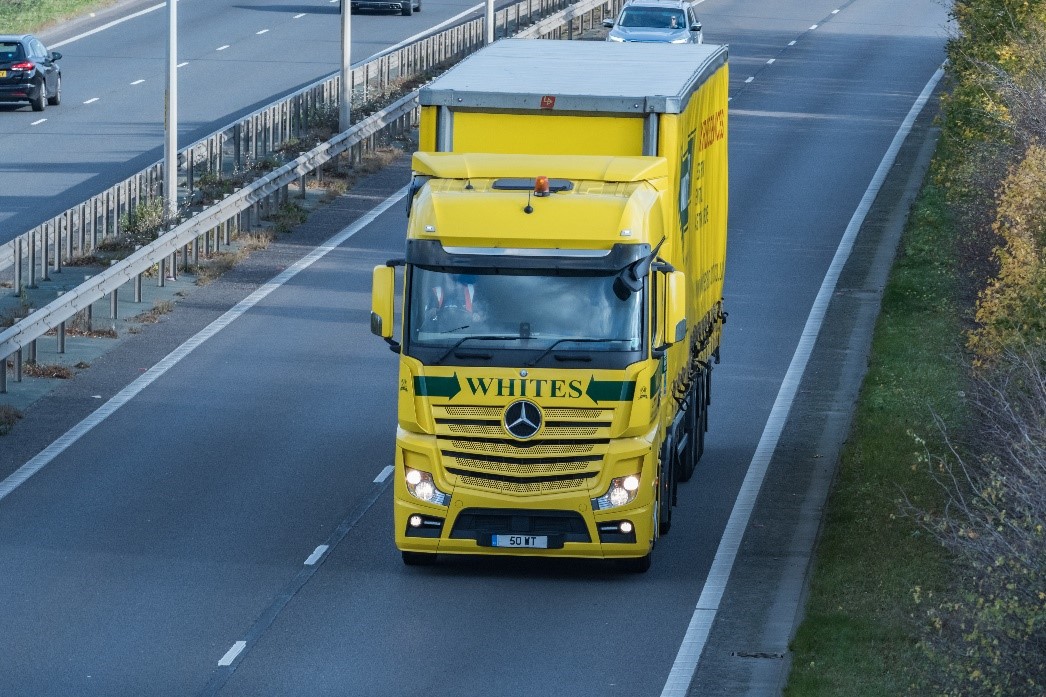 Introduction: Whites Transport Ltd is a family run business which has been supplying road haulage services to customers across the UK and Europe for over 60 years. Our close proximity to London, befits our customer base, delivering to businesses in London and the surrounding area. Our fleet consists of 36 vehicles, ranging from small vans and rigid vehicles, to 44 tonne articulated vehicles and HIABs.
Introduction: Whites Transport Ltd is a family run business which has been supplying road haulage services to customers across the UK and Europe for over 60 years. Our close proximity to London, befits our customer base, delivering to businesses in London and the surrounding area. Our fleet consists of 36 vehicles, ranging from small vans and rigid vehicles, to 44 tonne articulated vehicles and HIABs.
Jonathan White, Operations Director, explains how White’s Transport has achieved increased performance, an improved safety culture and achieved significant reductions in fuel usage, through FORS accreditation.
Section 2 – Following a request from one of our customers in 2011, we began investigating FORS membership. As an ISO 9001 certified company, we have always focussed on quality standards, and are constantly looking for ways to improve our safety standards and quality of service. The systems offered and encouraged by FORS were an obvious choice for us.
Section 3 – In October 2011, we successfully completed our initial Bronze audit. During the process we were pleased to identify improvements, both during the audit preparation process and the period following this, through access to FORS tools and training. Since achieving Bronze accreditation, in addition to the FORS performance management practices, and e-learning modules, we have benefitted through pre-qualification in requests for tender with companies such as DSJV (Crossrail project), ATC and Thames Tideway, where FORS membership is a contractual requirement for all suppliers.
Section 4- Having completed our Bronze accreditation, the commitment to progress to FORS Silver and then Gold was a natural evolutionally decision for White’s Transport. In 2013 we achieved that goal and have proudly maintained our Gold status during the subsequent six years. This has placed the company front and centre for pre-qualification in tenders for major projects. It has enabled the company to further improve upon its safe systems of work, its training of personnel and reduce the risk to vulnerable road users and the company’s exposure to such encounters. We believe that the FORS ethos is now wholly embedded within the company and we will continue to maintain and extol the virtues of the Gold standard.
Section 5 – Through our accreditation we have radically improved our training regime, taking advantage of e-learning modules, toolbox talks for staff, and the reduced cost of Advanced Check for FORS members. Year to date we have invested over 650 hours in driver training. These key benefits brought about immediate improvements in our operation, through more reliable checking of driver licences, and training modules. As a consequence of our reduced exposure to risk, the company received a refund of £15k on its insurance premium. This equates to a saving of approximately 25%. The company continues to be heavily focussed on vehicle and driver safety and this is maintained by the continued use of FORS e-learning modules, workshops and the provision of vital safety advice. We have followed the evolution of Vulnerable Road Users [VRU] equipment fitted to our vehicles and have recently gone beyond the requirements by electing to install vision-windows to the nearside doors of four new replacements in our fleet. This has led to improved vehicle safety and increased driver confidence in urban areas.
‘FORS has provided an excellent platform for improvement within our company and continues to offer innovative training and performance management tools. It has given us confidence to aspire to and achieve our Achilles accreditation.’
Jonathan White, Managing Director.
 Section 6 – Investment in the LoCity programme and more bespoke training, has resulted in improvements in fuel consumption and reduced collision incidents. Using telematics within the Teletrac Navman system, the company is able to accurately analyse and quantify specific indicators in its mission to reduce fuel use, reduce emissions and therefore improve air quality. The telematics data includes: total mileage; fuel usage; idling times; engine warm up time; heavy braking and provides an overall efficiency figure, based on all the aforementioned considerations. This is colour coded, with parameters set at: red – less than 25%; green – above 75% and yellow falling between the two. The efficiency report is based on litres/km, with a target of 31 litres per 100 km. Current figures reveal that 50% of the fleet have shown improvements. A bespoke Drivers’ CPC module has been introduced on the importance of the daily walk-round checks, including the significance of correctly monitored tyre pressures for safety and fuel consumption.
Section 6 – Investment in the LoCity programme and more bespoke training, has resulted in improvements in fuel consumption and reduced collision incidents. Using telematics within the Teletrac Navman system, the company is able to accurately analyse and quantify specific indicators in its mission to reduce fuel use, reduce emissions and therefore improve air quality. The telematics data includes: total mileage; fuel usage; idling times; engine warm up time; heavy braking and provides an overall efficiency figure, based on all the aforementioned considerations. This is colour coded, with parameters set at: red – less than 25%; green – above 75% and yellow falling between the two. The efficiency report is based on litres/km, with a target of 31 litres per 100 km. Current figures reveal that 50% of the fleet have shown improvements. A bespoke Drivers’ CPC module has been introduced on the importance of the daily walk-round checks, including the significance of correctly monitored tyre pressures for safety and fuel consumption.
White’s Transport has actively implemented mew measures in its quest to minimise the risk of incidents. Through a combination of training and further investment, it has introduced an annual health check, where all personnel have a medical examination by a practitioner. It is envisaged that this will identify conditions sooner, thus enabling early intervention and treatment. Additionally, all staff receive an annual eyesight test at Specsavers.
The company advertises through ‘Indeed’ for new staff and has rolled out a local advertising campaign aimed at recruiting local drivers. A series of advertising boards have been erected at a local service station in a prominent position thus maximising exposure. Additionally, the company seek to employ ex service personnel. Moreover, we encourage our own staff to further their careers by assisting non-drivers to take their vocational qualifications. Three staff have benefited from this. This creates a positive atmosphere and generates a sense of belonging and loyalty, with a bonus of aiding staff retention. All category C drivers are encouraged to advance to CE by the company. This is paid for by the company.
The company documented a report in January 2019, which undertook an assessed of noise exposure levels at White’s Transport Ltd.’s operating centre in Ramsgate, Kent. It includes recommendations of actions to be carried out to ensure that staff comply with the requirements of ‘The Control of noise at work regulations 2005’. During the assessment, all major operational areas of the vehicle yard inclusive of the yard, workshop, warehouse, office, welfare area and all access and egress points were included. The report included: Objectives; Conclusions; Recommendations; Noise assessment; Discussion and a Plan for reduction of noise levels found to exist. Risk assessments were created and communicated, and a strategy was adopted including procedures to minimise the risk. These included the use of appropriate PPE, a good regime of machine maintenance, health surveillance and information, instruction and training.
White’s Transport Ltd are committed to exploring the benefits of Modal shift and alternative vehicles however, due to the nature of our business, it has proved difficult. Presently, there is no alternatively fuelled vehicles available in the marketplace, which would replace, like-for-like, the current fleet. We are watching developments within the industry to see where it may be heading. We are particularly interested in following the Dutch specialist EMOSS who have developed a 16 tonne rigid on a Daf chassis for Calor. It has the potential to operate electrically for a 40 mile range, extendable to 250 miles with the use of a range-extending power unit, running on LPG. The LPG is combined with bio-diesel and has claimed CO2 reductions of 94%. The current problem is that the unit cost is between 2 to 2.5 times greater than its diesel alternative, with a significantly reduced payload. Additionally, we await to see greater improvements in the whole alternative fuels national infrastructure, which may benefit the industry. We are however, currently running a bio-diesel trial. Two of our vehicles have taken part in the trial. In summary, although there is evidence of a small increase in fuel efficiency, this has to be balanced with the requirement of additional workshop staff time devoted to ensuring the correct mixture is achieved. Additionally, there is a significant increase in maintenance costs due to filtering of bio-diesel. A longer term cost analysis is therefore required before firm commitment is made.
|
|
MPG |
CO2 |
NOx |
PM10 |
Number of PCNs | Proportion of fleet that uses alternative fuels |
| 2017 – 2018 | 11.8 | 2633 | 5549 | 101 | 9 | 0% |
| 2018 – 2019 | 12.4 | 2197 | 4546 | 83 | 4 | 5.5% |
| Percentage improvement | 4.8% | 16.5% | 18% | 18% | 55% | 5.5% |
Section 7 – The company has undertaken an upgrade programme subsequent to joining FORS. Sixty percent of the fleet are now Euro 6 and are therefore ULEZ compliant. The remainder of the fleet are Euro 5 and will be superseded as part of the company’s rolling replacement programme. Our programme includes the replacement of our vehicle cranes – to date, four have been delivered which are smaller, quieter and more fuel efficient and we have chosen to include vision-windows, in the nearside doors of our new lorries.
We will continue with our bio-diesel trial which has been running since March 2019, with the intention of making a firm decision after 12 months, when there will be sufficient data to conduct a cost analysis.
Investment in mental well-being is a priority and our General Manager is now a qualified Mental Health First Aider. We will continue to create more first aiders in the next 12 months.
We are passionate about being a more diverse workforce and would welcome the opportunity to employ more female & LBGT staff.
Section 8 – As an established FORS Gold member, we expect relevant contractors involved in transport and logistics within our supply chain, to also be part of the scheme. As part of this, we have reviewed our contractors’ requirements, and now require all contractors wishing to work with us to complete a questionnaire, a registration form and agree with our terms and conditions stating that all subcontractors must hold valid FORS accreditation, relevant to the contract they are required to undertake.
All of our vehicles promote the scheme by displaying the current FORS logo stickers on front, rear and sides of the bodywork. Additionally, our stationary clearly displays the FORS logo thereby promoting the scheme. Our advertising campaign displays the logo on the signage.
Section 9 –What FORS Gold accredition means for your organisation/to you?
White’s Transport Ltd is committed to focusing on the needs of the haulage industry and in particular the improvement of construction transport safety and standards in regard to work related road risk. As such, being a Gold accredited member illustrates that we are seen as having attained a high standing within our sector and that we were leading from the front, in the campaign to reduce road and site risk. We have always embraced change and in summary, we are seeing the benefits of ongoing progressive training, enabling us to reach the necessary FORS standards of performance and therefore drive down risk. Our staff have a newfound confidence, in that they know that the company will endeavour to do everything possible, to reduce their exposure to risk, and the people they interact with to a minimum. For the future, we aim to continue to ensure our ongoing development as a company, continuing to reflect the values which underpin the high standards which the FORS scheme represents. Our goal is to continually evolve, with the aim of reducing risk to an absolute minimum.
Section 10 – https://www.linkedin.com/company/11353719/ , https://www.facebook.com/profile.php?id=100009360606755
Section 11 – FORS members’ feedback questionnaire
Please could you take the time to complete a short questionnaire and provide feedback about FORS. Please note all answers you provide will be strictly confidential and will only be used by FORS to help us to improve the scheme. To access the survey, please click the link here: https://www.snapsurveys.com/wh/s.asp?k=153908006313
Please note: All published FORS Gold case studies have been submitted by the accredited company named above and transcribed verbatim

